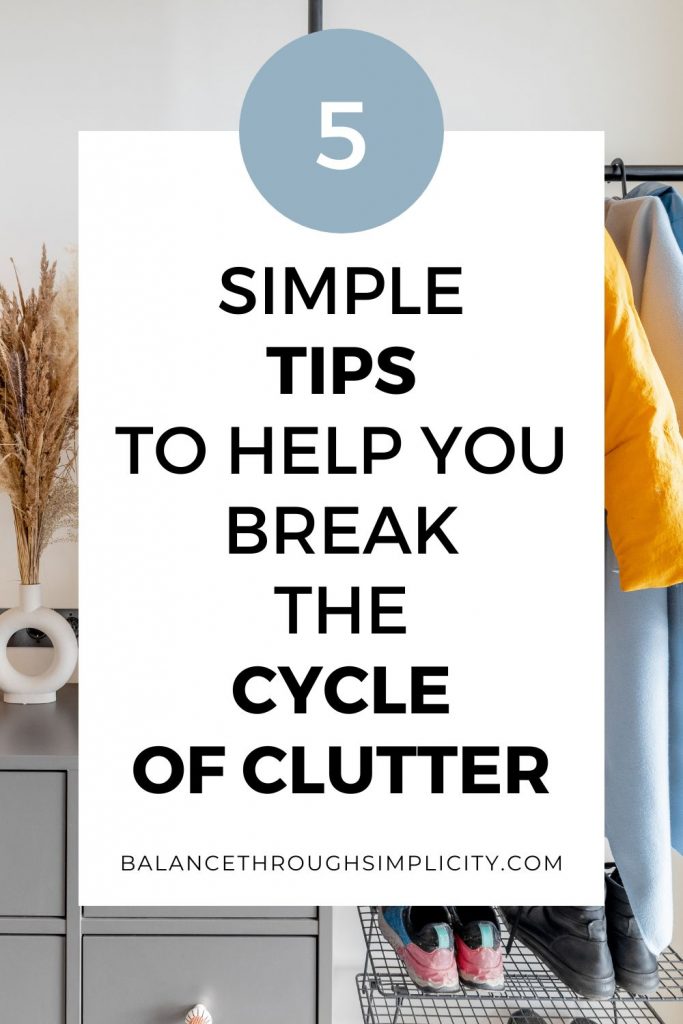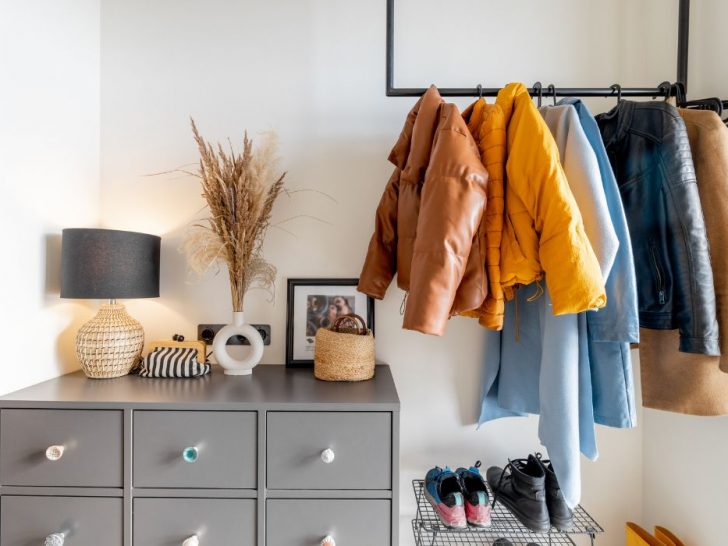THE CLUTTER CYCLE: 5 TIPS TO HELP YOU BREAK THE CYCLE OF CLUTTER
Do you declutter but then find your home fills up again with stuff so you have to declutter again? Does the cycle of clutter repeat itself and bring down your motivation and energy levels at the same time? If this sounds familiar then you may be trapped in the clutter cycle. Here are 5 tips to help you break the cycle of clutter and stay clutter-free!
HOW TO BREAK THE CLUTTER CYCLE
Clutter is a sneaky beast. It keeps on coming into our homes and lives without us really noticing it. From the emails lurking in our inbox, to the junk mail popping through our letterbox, the random papers that collect on our kitchen counters to the set of porcelain crockery passed down to us from Great Aunt Mildred.
There are many types of clutter. Stuff that we can see and also stuff that we can’t. Yet, the clutter finds a way to make a base for itself in our home, our schedule, our mind, heart and life.
For anyone who’s tried to declutter, I’m sure you’ve not found it all plain sailing. I know I struggled to begin with.
I didn’t know where to start, how to decide what to keep and what to get rid of, how to find the motivation, energy and time. I made plenty of mistakes and changed tactics, time and time again… until I found a way to break the clutter cycle once and for all.
WHAT IS THE CLUTTER CYCLE?
The clutter cycle happens when we clear our clutter, only for it to build up again.
So we declutter again and then the clutter builds up.
Not only is this clutter-declutter-clutter-declutter scenario frustrating but it’s also time-consuming, energy-sapping, demotivating and demoralising.
Why would we want to keep putting in the effort to declutter if we know that the clutter cycle will happen again and our clutter will build up again before long?
Decluttering can be hard enough but knowing that your efforts might well be in vain can be harder still.
Even if you realise that you need to declutter, you want to feel the benefits of a decluttered home and you’re willing to put in the hard work, at some point the clutter cycle might just defeat you.
Until, that is, you find a way to break the cycle of clutter once and for all.

5 TIPS TO HELP YOU BREAK THE CLUTTER CYCLE
The clutter cycle is not a surprising phenomenon and it affects many of us so don’t feel you’re alone if you’re reading this and it’s starting to feel a little familiar.
It doesn’t mean that you’re decluttering wrong, that you’re making bad decisions, that your clutter will hold power over you for evermore, or that a busy and full life just requires us to put up with the clutter that inevitably comes with it.
If you feel you’re stuck in the clutter cycle, it may just mean that you haven’t addressed some of the real reasons why clutter builds up repeatedly.
Here are some tips to help you break the cycle of clutter in your own home and life.
1. Stop shopping
We all need to go shopping every now and then, particularly for food when we’ve run low of stocks. So, I say ‘stop shopping’ as the first step to breaking the clutter cycle with a pinch of salt. I don’t mean stop shopping completely but I do encourage you to shop shopping for things generally.
Have a no-spend month where you only buy essentials that you absolutely, hand-on-heart, know you’re going to need and use in the short-term.
- No long term investments, no purchases that you haven’t thought through long and hard.
- No impulse buys and no hitting the shops when you’re bored or upset.
- No purchases hidden under the guise of saving money or making life easier such as stock-piling shampoo or buying 3 for the price of 2.
Shopping (for things that you don’t need) fills up your space wastes money. When you’ve spent time decluttering your floor, worktops, tabletops, cupboards and closets, the last thing you should do is clutter them back up with new purchases.
Stop shopping for the time-being. Don’t bring more stuff into your home until you’ve dealt with and got on top of the stuff you already have.
This is my first and very important tip on how to break the clutter cycle in your home.
2. Put things away
The next tip for breaking that clutter cycle is to make sure that you put things away after you’ve used them. Your home may be clutter-free, totally simplified and minimalist or somewhere in the middle of the spectrum but one thing is fairly universal…
If you don’t put things away when you’re not using them, your home will instantly feel and look (even) more cluttered.
Putting things away is a habit to keep your home clutter-free. It’s relatively easy, simple and quick and children and adults of all ages can help to put things away after they’ve been used.
It just takes perseverance and practice to make putting things away a habit. A regular activity that you do without really thinking about it.
Here are some examples:
- Put your bag and coat away the moment you walk in through your front door
- Put letters and junk mail in the tray on your hall table to action during your regular weekly planning
- Put toys away after they’ve been played with
- Put dishes away after they’ve been used, washed, rinsed and dried
- Put your hobby, art and craft materials away after you’ve used them
Even if your home is simplified and minimalist, it’s easy for it to feel messy and cluttered after your kids have spent the morning playing in the living room. And, that’s the way it should be.
Your kids, and you, need to feel comfortable at home and enjoy making creative messes. A decluttered home shouldn’t be about stopping you doing things because it creates clutter. That’s when decluttering goes too far. Instead, it’s about making sure that it’s as quick and easy to clear up afterwards as possible.
Put your things away after you’ve finished and enjoyed using them. This will help keep your home clutter-free and helps break the clutter cycle.
3. Limit storage
In my hallway I used to have a large table with drawers. It was too big for the space so I eventually swapped it for a smaller table without drawers. Not only does it look more in proportion to the size of the room but I noticed that less clutter built up on it.
There just wasn’t the space on, or in, for stuff to build up. We no longer kept the excess ornaments, the leaflets and brochures we weren’t sure what to do with so just left them on the side, or the multiple dog leads, scarves or pot of pens and pencils.
So, my next suggestion for helping to stop the clutter cycle is to have less storage. This could, of course, go two ways:
Either, that you just don’t have anywhere to store your stuff so it ends up cluttering the floor, tabletops and piling up in every corner of your home. Or, and I hope more probable,
That you decide to get rid of some of your stuff because you don’t have a home for it when it’s not in use!
When we have less storage:
- We’re less tempted to keep things
- There’s no out-of-sight and out-of-mind
- We have more physical space
- There’s less to clean, tidy, sort and organise
- Everything we keep is used more regularly and serves a purpose
Break the clutter cycle by having less storage and so you keep less clutter.

4. Raise your awareness of clutter
This may sound obvious, to be aware of what clutters your home, but sometimes we fail to see the obvious when we’re so used to looking at it in a certain, familiar way.
Clutter builds up pretty easily in some places. These are called clutter hotspots and they’re places of high usage and high traffic. They’re often dumping grounds for clutter that we haven’t bothered to put away or don’t really know where it should go elsewhere in the house. The hall table and kitchen counter are notorious clutter hotspots.
Once one piece of clutter finds its way onto a surface or into a cupboard, it’s easy for yet more clutter to join it. Clutter has its very own law of attraction because once one little bit of clutter is present, yet more clutter will easily find its way to join it too.
That’s why keeping our homes clutter-free is a great way to stop attracting yet more clutter.
However, when we don’t stay vigilant and aware of clutter then we fail to see when our clutter builds up. We become used to the sight of piles and stuff, we don’t recognise when a small pile of clutter becomes a big clutter mountain because we never really look with fresh eyes. We become accustomed and used to the clutter in our homes. We become clutter-blind.
And, when we become blind to the clutter, we inevitably become more tolerant of it and just accept that clutter is a natural part of busy, modern life.
Although understandable, clutter isn’t necessary. There are many ways to declutter but they all require an awareness of what clutter is and how it builds up.
Once we’re aware of the problem then we can take steps to deal with it. On the flip side, if you declutter once and then ‘switch off’ to the clutter, then your clutter will creep back in when you’re not paying attention. Then you’ll feel your home is cluttered, so you’ll declutter a bit and then the clutter will come back in time.
Without a raised awareness of clutter and vigilance for it in your home and life, it’s unlikely you’ll break the clutter cycle.
5. Declutter regularly
The other tip which I highly recommend is to make a date with yourself to declutter regularly. Block out a day or window of time in your day every week or month to declutter a room or part of a room and stick to it.
Make decluttering fun, get your family to help, be creative with what you declutter and when. Get into a decluttering mindset, plan your decluttering goals and what you want to achieve, gather any decluttering supplies you might need beforehand and pop on some music.
Whether it’s five minutes or five hours, regular decluttering will help you stay on top of your clutter. If clutter invades your space regularly then regular declutter sessions will help keep your stuff in check so it never really gets the chance to build up.
Here are some tips on how to declutter fast if time is tight.
When can you next plan a declutter session and what will you declutter in the time you have available? Use my free Decluttering Action Plan at the bottom of this article to help you create a plan of attack!

IN CONCLUSION
The clutter cycle can be disheartening if you’ve worked hard at decluttering but struggle to stop it building up again. If this is familiar, then I hope the ideas I’ve shared in this article will help. It might be that you’re decluttering just fine. You know what to declutter and how to do it, but perhaps you’ve haven’t found a way to close the process – to stop the clutter building back up. If this is a problem in your home, I suggest you:
- Stop shopping to prevent bringing in yet more new clutter
- Put things away when you’re not using them so your home stays clutter-free, neatier and tidier
- Limit storage so you can’t hide things away or keep things ‘just in case’ you might use them one day
- Raise your awareness of clutter so you stay vigilant for when it creeps up on you!
- Declutter regularly so clutter doesn’t get a chance to build up
SHARE YOUR THOUGHTS
I’d love to know whether you feel stuck in the clutter cycle? Are you still stuck or did you find a way to break it? If so, how? Do you have any other tips to share on how to deal with clutter on an ongoing basis? Leave a comment below as I’d love to hear from you!
ARTICLES TO HELP YOU DECLUTTER AND BREAK THE CLUTTER CYCLE
- 10 Things to Declutter That Aren’t Actual Things
- Things that make your home look cluttered
- How to declutter your home and life
- Hidden clutter and how to deal with it
- 35 Journal Prompts for Decluttering Your Home and Life with Clarity and Ease
- 15 Reasons Why Decluttering is Hard (And How To Make It Easier)
DON’T MISS OUT!
I’m Antonia and on this blog I share practical inspiration to simplify your home, time and life. Follow me on Instagram, Facebook and Pinterest! You can also subscribe to Balance Through Simplicity and receive regular simplicity tips straight to your inbox for free. Make sure you never miss an article plus you’ll get a copy of my free Declutter Starter Kit as a welcome gift!


Laura
Sunday 5th of March 2023
I needed this reminder today - thank you! I've been working on shopping a lot less, including stocking up on "just in case" or "good intentions" pantry items. I feel right now like I'm at the stage where it feels worse before it gets better, with bags of donations to take in cluttering up my entrance, but they go out the door TODAY.
Thanks so much for all your great articles. They help me to keep going when the last thing I feel like doing is tackling my clutter.
Balance Through Simplicity
Sunday 5th of March 2023
Hi Laura, thank you so much for your lovely comment. I'm so pleased you find my articles helpful as inspiration but you are the one doing all the hard decluttering work so well done! Sending encouragement and moral support in a virtual kind of way back to you! Antonia